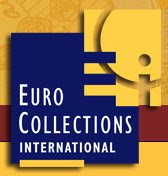
With the release of the Abbey of Seckau silver coins on October 8th, the Austrian Mint have concluded their widely popular 10 Euro commemorative coin series entitled "Great Abbeys of Austria". The silver coin series, started in 2006 with the release of the Nonnberg Abbey coin, has seen 6 issues released over the last 2 years, with each issue available in both Silver Proof and Brilliant Uncirculated condition.
This final issue, commemorating the Benedictine Abbey at Seckau in the northern province of Styria is, like its predecessors, a work of incredible craftsmanship. The stunning attention to detail depicted in all the coins in this series is simply breath taking, but none so much as this final issue.
No mint manages to make such incredible use of their coin flans as the Austrian Mint does and this coin (as with others in the Abbey series) is no exception. The Obverse design on this Austrian coin carries a view of the Abbey and Basilica shown from the east. This aerial depiction displays the general cross-shaped design of the structure. Towards the top of the coin are the two great towers that flank the Abbey's main entrance. The fine design work in illustrating everything from the roof slats, windows, brickwork and surrounding foliage is truly remarkable and most certainly eye catching. Also included on this side is the country of issue "REPUBLIK OESTERREICH" (Republic of Austria), the denomination of 10 Euros, the year of issue, 2008, and the name of the abbey itself "BENEDIKTINER ABTEI SECKAU" (Benedictine Abbey Seckau).
On the Reverse side things go a step further with the magnificently detailed image of the nave of the Romanesque church looking down towards the high altar. A crucifixion group hangs above the altar from four large chains. The Romanesque archways that lead down on each side, accompanied by the intricate Gothic ceiling, give this design a depth rarely seen on any coin. The coin has an almost three dimensional quality, enhanced by the church pews in the foreground.
The following information about the Seckau Abbey is taken from the Austrian Mint press release:
Seckau did not begin its existence as a Benedictine foundation. It was founded in 1140 as an abbey of Augustinian canons at St. Marein-Feistritz by a nobleman, Adalram von Waldeck - apparently as a penitential act for the death of his cousin. The place proved unsuitable, and in 1142 the abbey was moved to near-by Seckau. A year later Pope Innocent II placed the new foundation directly under papal protection. It was to be a double monastery with nuns (canonesses) from Salzburg forming a separate but adjoining convent. In 1150 they began to build the splendid Romanesque church which we still see today. In 1259 a fire destroyed much of the wooden ceiling and it was replaced with Gothic stone vaulting instead.
From 1218 Seckau was the seat of the new bishopric for Styria. The convent of canonesses was closed in the late 1500's. The biggest change came, however, in 1782 when the Emperor Joseph II instituted a policy of closure of those monastic establishments which he classified as "unproductive". The bishop’s seat was transferred to Graz and the basilica of Seckau with its adjoining Baroque complex was left deserted for just on one hundred years.
Bismarck’s Kulturkampf in 19th century Germany caused Benedictine monks from the southern German Abbey of Beuron to flee for protection to Austria. Emperor Franz Joseph gave them refuge firstly in Tyrol and then from 1880 in Prague. Their increasing numbers forced them to seek a second foundation, and in 1883 they bought the rights to Seckau. A new phase of life as a Benedictine abbey began. Three years later the north tower of the church collapsed and the monks rebuilt both towers more safely. In 1926 they opened a school.
During the second World War the abbey was closed. In 1945, the monks returned to what remained of the abbey. The energetic and hard working monks have succeeded in accumulating an impressive library of over 100,000 volumes. The abbey school was reopened, and girls have been admitted to the school since the 60's. One of the brothers ran a successful and well-known school for silver and goldsmiths until 1997. The abbey also houses on of the most significant works of sacred art from the modern era, a series of frescoes by H. Boeckl completed from 1952 to 1960. The frescoes depict scenes of the Revelation of St John the Divine and are located in the Angel Chapel.
The Seckau Abbey Silver Proof and Brilliant Uncirculated coin, as with the previous issues in this series, has a face value of 10 Euro and is struck in 92.5% fine silver. The Proof coins have a maximum mintage of 60,000 and are housed in an official case with numbered Certificate of Authenticity, while the BU coins have a mintage of 40,000 and are presented in a colourful information folder. Each coin is 32mm in diameter and weighs 16 grams.
The Seckau Abbey coin is the sixth and final issue in the "Great Abbeys of Austria" series, with the previous five issues featuring the following abbeys:
 Nonnberg Abbey (2006) |  Göttweig Abbey (2006) |
 Melk Abbey (2007) |  St. Paul in Lavanttal (2007) |
 Klosterneuburg (2008) |
All 6 coins in the Great Abbeys of Austria series are now available at Euro Collections in both Silver Proof and Brilliant Uncirculated condition.





No comments:
Post a Comment